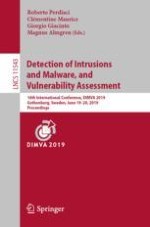2019 | OriginalPaper | Chapter
Practical Password Hardening Based on TLS
Authors : Constantinos Diomedous, Elias Athanasopoulos
Published in: Detection of Intrusions and Malware, and Vulnerability Assessment
Publisher: Springer International Publishing
Activate our intelligent search to find suitable subject content or patents.
Select sections of text to find matching patents with Artificial Intelligence. powered by
Select sections of text to find additional relevant content using AI-assisted search. powered by
Abstract
mod_ssl, the module that offers TLS to any Apache web server, to act as a password-hardening service. Our evaluation shows that with an overhead similar to adapting hash functions (such as scrypt and bcrypt), our proposal can protect even the weakest passwords, once they are leaked.
